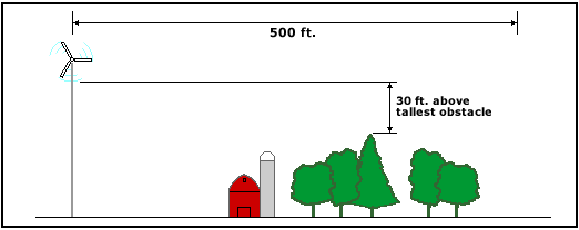Site Selection for Wind Turbines
Building a wind turbine is far more than simply a matter of finding a field or mountaintop where the wind is blowing and plopping one down. Engineers give a great deal of attention to finding the proper site for a wind turbine. The main factor they consider is the average speed of the wind over an extended time. Using a wind-cup anemometer, engineers take extensive measurements of wind speed over a long time.
Wind Speed
Wind speed measurements have to be precise. If engineers overestimate the amount of wind, the power output of the turbine can be reduced considerably. If, for example, wind is believed to average 10 miles (16 kilometers) per hour but is only 9 miles (14 kilometers) per hour, the power output of the turbine is reduced 27 percent. If the wind speed is only 8 miles (13 kilometers) per hour, the power output is 41 percent less than expected. If the wind speed is higher than believed, power output increases. If the wind speed is 11 miles (18 kilometers) per hour, the power generated increases 33 percent. If the wind speed is much higher than expected, the equipment may be too small and too fragile for the site.
Turbine Height
In general, wind turbines should be sited well above trees, buildings, and other obstacles. When the wind flows over an obstacle like a building or a tree, the wind is slowed down and turbulent air is created, and if a wind turbine is located in this zone of turbulence, the result will be poor energy production and increased wear and tear on the turbine. One way to get above the zone of turbulence is to put the wind turbine on a tall tower.

The above image is an illustration of a simple rule-of-thumb that is often used to specify a minimum tower height for a residential-sized wind turbine. The rule-of-thumb is to make sure that the tower is tall enough so that the entire turbine rotor is at least 30 feet above the tallest obstacle within 500 feet of the tower. Because trees grow and towers don't, make sure to consider the growth of trees over the lifetime of the wind turbine (typically 20 - 30 years between major rebuilds) as well.
Other Considerations
When looking for a place for a wind turbine, engineers consider factors such as wind hazards, characteristics of the land that affect wind speed, and the effects of one turbine on nearby turbines in wind farms. The following factors are important:
• Hill effect. When it approaches a hill, wind encounters high pressure because of the wind that has already built up against the hill. This compressed air rises and gains speed as it approaches the crest, or top, of the hill. Siting wind turbines on hilltops takes advantage of this increase in speed.
• Roughness, or the amount of friction that Earth's surface exerts on wind. Oceans have very little roughness. A city or a forest has a great deal of roughness, which slows the wind.
• Tunnel effect, or the increase in pressure air undergoes when it encounters a solid obstacle. The increased air pressure causes the wind to gain speed as it passes between, for example, rows of buildings in a city or between two mountains. Placing a wind turbine in a mountain pass can be a good way to take advantage of wind speeds that are higher than those of the surrounding air.
• Turbulence, or rapid changes in the speed and direction of the wind, often caused by the wind blowing over natural or artificial barriers. Turbulence causes not only fluctuations in the speed of the wind but also wear and tear on the turbine. Turbines are mounted on tall towers to avoid turbulence caused by ground obstacles.
• Variations in wind speed. During the day, winds usually blow faster than they do at night, because the sun heats the air, setting air currents in motion. In addition, wind speed can differ depending on the season of the year. This difference is a function of the sun, which heats different air masses around Earth at different rates, depending on the tilt of Earth toward or away from the sun.
• Wake. Energy cannot be created or destroyed. As wind passes over the blades of a turbine, the turbine seizes much of the energy and converts it into mechanical energy. The air coming out of the blade sweep has less energy because it has been slowed. The abrupt change in speed makes the wind turbulent, a phenomenon called wake. Because of wake, wind turbines in a wind farm are generally placed about three rotor diameters away from one another in the direction of the wind, so that the wake from one turbine does not interfere with the operation of the one behind it.
• Wind obstacles, such as trees, buildings, and rock formations. Any of these obstacles can reduce wind speed considerably and increase turbulence. Wind obstacles such as tall buildings cause wind shade, which can considerably reduce the speed of the wind and therefore the power output of a turbine.
• Wind shear, or differences in wind speeds at different heights. When a turbine blade is pointed straight upward, the speed of the wind hitting its tip can be, for example, 9 miles (14 kilometers) per hour, but when the blade is pointing straight downward, the speed of the wind hitting its tip can be 7 miles (11 kilometers) per hour. This difference places stress on the blades. Too much wind shear can cause the turbine to fail.
Site Selection for Wind Turbines copyright 2011 Digtheheat.com
